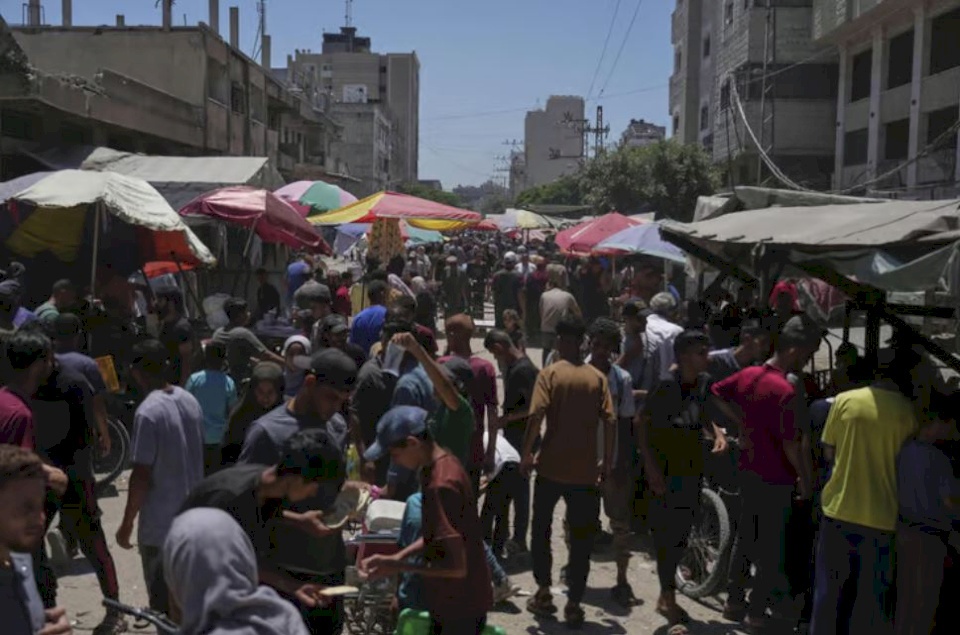
Gaza Under Siege: Basic Commodity Prices Reach Astronomical Levels
SadaNews Economy - The markets of the Gaza Strip are witnessing an unprecedented wave of inflation, with the prices of basic commodities reaching astronomical levels that have made them inaccessible for most of the population. As humanitarian aid has become a rare and risky commodity, securing a livelihood has turned into a daily battle amid a war that extends beyond bombs to the hunger of the starving, according to the New York Times.
Since Israel reorganized the mechanism for distributing aid in May, under the pretext of preventing it from leaking to Hamas, distribution points have become the scene of chaos and bloodshed. According to field testimonies, many Gazans have abandoned the attempt to reach these points, fearing death or stabbing in desperate crowds, which local sources have described as "death traps."
In local markets, where commercial goods mix with relief supplies and some locally grown products, food prices have risen to a degree that has made much of it lose its meaning, according to Aref Hussein, chief economist at the United Nations World Food Program.
For example, the price of sugar has skyrocketed to about $106 per kilogram, up from just 89 cents before the war.
Meanwhile, flour has reached $12 per kilogram (up from 42 cents), and tomatoes have hit $30 (compared to 59 cents previously), according to field surveys conducted by chambers of commerce in the governorates of Gaza, Deir al-Balah, and Khan Yunis.
These prices, which change daily according to the entry or prohibition of trucks, have pushed many to exhaust their meager savings to buy small quantities of flour or lentils. Mohamed Fares, a young man from Gaza whose home was destroyed in the war, stated that he has lost about 23 kilograms of weight, adding, "The prices are insane, completely insane... and I am no longer willing to risk my life for aid."
Data from the Gaza Chamber of Commerce shows dramatic price fluctuations: a 25-kilogram bag of flour sold for $891 on July 20, then dropped to $223 after a few days, before rising again to $334 within a week. It is noted that its price was not more than $10 before the war.
Eyad Abu Ramadan, head of the Gaza Chamber of Commerce and president of the emergency committee of the chambers of commerce, points out that the tightened siege between March and May has returned prices to terrifying levels after witnessing a temporary decline during the recent ceasefire. He added: We are not only facing a war with bombs, but another war with hunger, thirst, and food prices.
Even non-food items have not escaped the flames of rising prices. The price of a bar of soap has risen to about $10, a pack of diapers to $149, while a 400-gram baby formula canister costs around $51. A liter of diesel has reached $36, compared to $1.87 before the war.
For comparison, the price of a liter of diesel in the United States is just one dollar, and you can buy 40 diapers for about $5.
The residents face an additional dilemma of cash shortage, as banks have been destroyed, and ATMs have stopped working. The local currency (Israeli shekel) has turned into a commodity traded on the black market with commissions that can reach up to 50 percent, paid in internet cafes or on street corners.
In his daily description of the situation, young Mohammed Fares said: "Suffering has become an integral part of every detail of life... suffering upon suffering."

The Palestinian Economy at a Crossroads: 4 Files Awaiting Resolution

Telecommunications Regulatory Authority Issues Decision to Regulate the Import of Mobile P...

Conclusion of the Christmas Season "Light and Smile" Events at Q Center Rawabi

Increase in Goods Exports in Palestine by 37% During September 2025

Launch of the 10th Coffee and Chocolate Exhibition in Ramallah

Amid Political Ambiguity, the Palestinian Economy Faces Three Scenarios in 2026

Listed Companies as a Major Workforce Provider and a Source of National Economy
